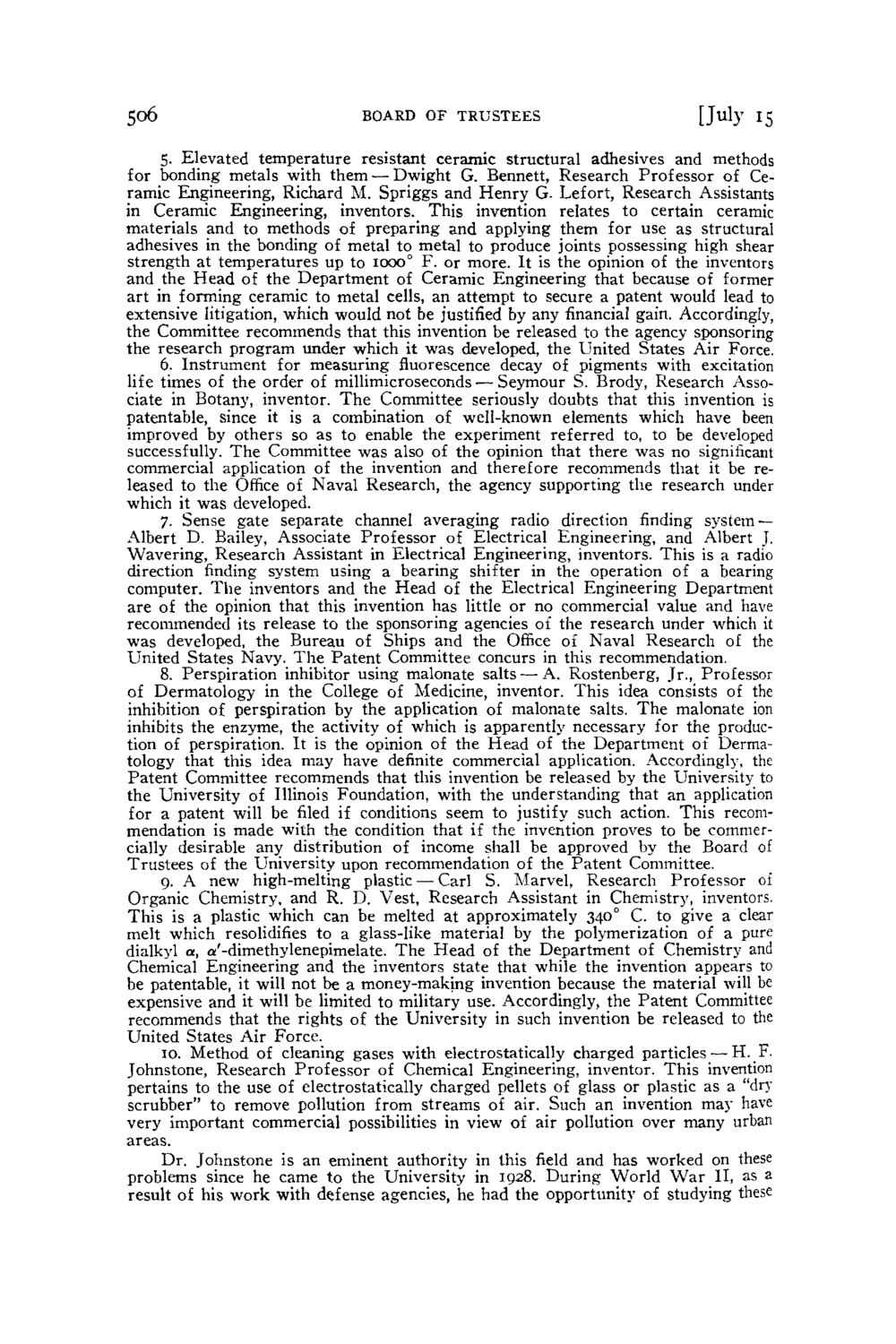| |
| |
Caption: Board of Trustees Minutes - 1958
This is a reduced-resolution page image for fast online browsing.

EXTRACTED TEXT FROM PAGE:
506 BOARD OF TRUSTEES [July 15 5. Elevated temperature resistant ceramic structural adhesives and methods for bonding metals with them — Dwight G. Bennett, Research Professor of Ceramic Engineering, Richard M. Spriggs and Henry G- Lefort, Research Assistants in Ceramic Engineering, inventors. This invention relates to certain ceramic materials and to methods of preparing and applying them for use as structural adhesives in the bonding of metal to metal to produce joints possessing high shear strength at temperatures up to iooo 0 F. or more. It is the opinion of the inventors and the Head of the Department of Ceramic Engineering that because of former art in forming ceramic to metal cells, an attempt to secure a patent would lead to extensive litigation, which would not be justified by any financial gain. Accordingly, the Committee recommends that this invention be released to the agency sponsoring the research program under which it was developed, the United States Air Force. 6. Instrument for measuring fluorescence decay of pigments with excitation life times of the order of millimicroseconds — Seymour S. Brody, Research Associate in Botany, inventor. T h e Committee seriously doubts that this invention is patentable, since it is a combination of well-known elements which have been improved by others so as to enable the experiment referred to, to be developed successfully. The Committee was also of the opinion that there was no significant commercial application of the invention and therefore recommends that it be released to the Office of Naval Research, the agency supporting the research under which it was developed. 7. Sense gate separate channel averaging radio direction finding system — Albert D. Bailey, Associate Professor of Electrical Engineering, and Albert J. Wavering, Research Assistant in Electrical Engineering, inventors. This is a radio direction finding system using a bearing shifter in the operation of a bearing computer. The inventors and the Head of the Electrical Engineering Department are of the opinion that this invention has little or no commercial value and have recommended its release to the sponsoring agencies of the research under which it was developed, the Bureau of Ships and the Office of Naval Research of the United States Navy. T h e Patent Committee concurs in this recommendation. 8. Perspiration inhibitor using malonate salts — A. Rostenberg, Jr., Professor of Dermatology in the College of Medicine, inventor. This idea consists of the inhibition of perspiration by the application of malonate salts. The malonate ion inhibits the enzyme, the activity of which is apparently necessary for the production of perspiration. It is the opinion of the Head of the Department of Dermatology that this idea may have definite commercial application. Accordingly, the Patent Committee recommends that this invention be released by the University to the University of Illinois Foundation, with the understanding that an application for a patent will be filed if conditions seem to justify such action. This recommendation is made with the condition that if the invention proves to be commercially desirable any distribution of income shall be approved by the Board of Trustees of the University upon recommendation of the Patent Committee. 9. A new high-melting plastic — Carl S. Marvel, Research Professor of Organic Chemistry, and R. D. Vest, Research Assistant in Chemistry, inventors. This is a plastic which can be melted at approximately 340° C. to give a clear melt which resolidifies to a glass-like material by the polymerization of a pure dialkyl a, a'-dimethylenepimelate. The Head of the Department of Chemistry and Chemical Engineering and the inventors state that while the invention appears to be patentable, it will not be a money-making invention because the material will be expensive and it will be limited to military use. Accordingly, the Patent Committee recommends that the rights of the University in such invention be released to the United States Air Force. 10. Method of cleaning gases with electrostatically charged particles •— H. F. Johnstone, Research Professor of Chemical Engineering, inventor. This invention pertains to the use of electrostatically charged pellets of glass or plastic as a "dry scrubber" to remove pollution from streams of air. Such an invention may have very important commercial possibilities in view of air pollution over many urban areas. Dr. Johnstone is an eminent authority in this field and has worked on these problems since he came to the University in 1928. During World W a r II, as a result of his work with defense agencies, he had the opportunity of studying these
| |